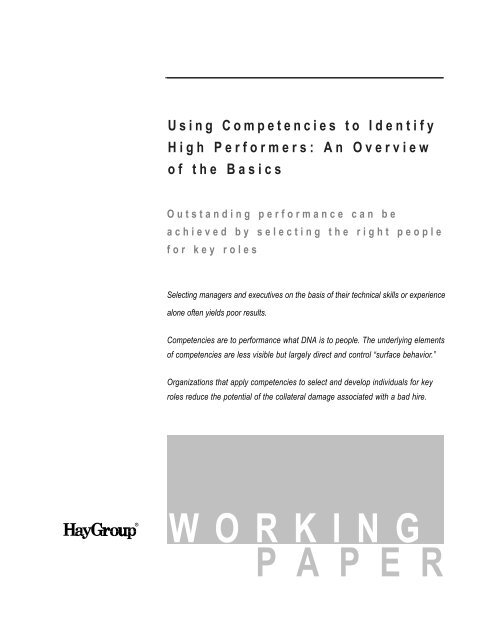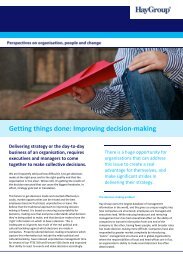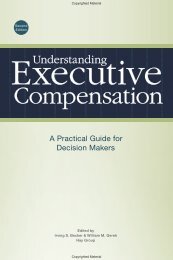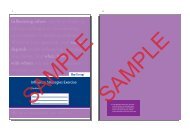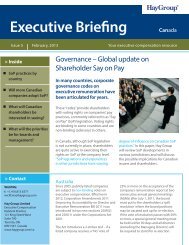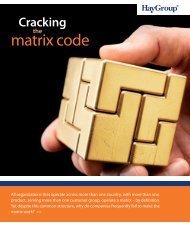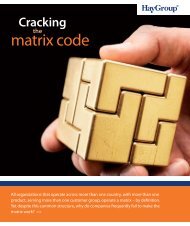Using Competencies to Identify High Performers - Hay Group
Using Competencies to Identify High Performers - Hay Group
Using Competencies to Identify High Performers - Hay Group
Create successful ePaper yourself
Turn your PDF publications into a flip-book with our unique Google optimized e-Paper software.
<strong>Using</strong> <strong>Competencies</strong> <strong>to</strong> <strong>Identify</strong><br />
<strong>High</strong> <strong>Performers</strong>: An Overview<br />
of the Basics<br />
Outstanding performance can be<br />
achieved by selecting the right people<br />
for key roles<br />
Selecting managers and executives on the basis of their technical skills or experience<br />
alone often yields poor results.<br />
<strong>Competencies</strong> are <strong>to</strong> performance what DNA is <strong>to</strong> people. The underlying elements<br />
of competencies are less visible but largely direct and control “surface behavior.”<br />
Organizations that apply competencies <strong>to</strong> select and develop individuals for key<br />
roles reduce the potential of the collateral damage associated with a bad hire.<br />
WORKING<br />
P A P E R
<strong>Using</strong> <strong>Competencies</strong> <strong>to</strong> <strong>Identify</strong><br />
<strong>High</strong> <strong>Performers</strong>: An Overview<br />
of the Basics<br />
Organizations can achieve outstanding<br />
performance by selecting the right<br />
people for key roles<br />
Introduction 1<br />
What Is a Competency? 2<br />
Why Use a Competency-based Approach? 4<br />
Stages of Competency Definition 5<br />
1. Performance Criteria 6<br />
2. Criterion Sample 6<br />
3. Data Collection 6<br />
4. Competency Model Development 8<br />
5. Validation 8<br />
6. Application 9<br />
Innovative Applications of <strong>Competencies</strong> 10<br />
Conclusion 11<br />
Copyright © 2003 <strong>Hay</strong> <strong>Group</strong>, Inc. All rights reserved in all formats.
McClelland confirmed that<br />
traditional predic<strong>to</strong>rs of<br />
performance such as aptitude<br />
tests, examination results,<br />
and references did not in fact<br />
predict job performance.<br />
WORKING<br />
PAPER<br />
1<br />
W<br />
e’ve all seen it happen: Two motivated individuals with similar education,<br />
experience, and skills are promoted in<strong>to</strong> new roles. One quickly turns in<strong>to</strong><br />
a star performer, achieving outstanding results with apparent ease. The other struggles<br />
just <strong>to</strong> achieve the minimal level of success, frustrating both him and others.<br />
Why, we ask, was one so much more successful than the other?<br />
It’s a good question, one that continues <strong>to</strong> challenge organizations <strong>to</strong>day. If<br />
the brightest and even most experienced do not always succeed in the workplace,<br />
then what can businesses do <strong>to</strong> identify their potential star performers?<br />
They can begin by throwing out the IQ tests and other proxies that measure<br />
intellect. Renowned Harvard University Psychologist David McClelland confirmed<br />
this in an article he published in 1973 entitled “Testing for competence rather<br />
than for intelligence.” McClelland summarized a number of studies that showed<br />
that aptitude tests, which had traditionally been used by psychologists <strong>to</strong> predict<br />
performance, did not in-fact predict job performance. Additionally, the tests<br />
were often culturally based and therefore prone <strong>to</strong> bias. He also discovered that<br />
other traditional measures used in the hiring process, such as examination<br />
results and references, were equally poor at predicting success on the job.<br />
McClelland set out <strong>to</strong> find an alternative <strong>to</strong> the traditional aptitude and intelligence<br />
testing, which yielded a deeper measure that he labeled “competencies.”<br />
A competency is defined as an underlying characteristic of a person which<br />
enables them <strong>to</strong> deliver superior performance in a given job, role, or situation.<br />
In the process of his research on competencies, McClelland established two key<br />
<strong>to</strong>ols—criterion samples and behavioral event interviews—<strong>to</strong> help enable his approach.<br />
Criterion Samples<br />
By studying two distinct (criterion) groups—star and average performers—<br />
McClelland sought <strong>to</strong> understand what really differentiated performance and<br />
created success in a job. This method, which proved <strong>to</strong> be highly successful in<br />
predicting the future success of individuals, formed the foundation for <strong>Hay</strong><br />
<strong>Group</strong>’s approach <strong>to</strong> assessment, selection, and development. It is elegant in its<br />
conceptual simplicity and application.
Behavioral Event Interviews (BEI)<br />
To understand what makes the best people successful, McClelland sought <strong>to</strong><br />
understand not just what they do, but the thoughts and feelings that generate<br />
their actions. The Behavioral Event Interview (BEI) is a highly structured interview<br />
that focuses on the characteristics of the person being interviewed rather<br />
than on the work content.<br />
The BEI identifies the deep-rooted thoughts and behavior patterns of people<br />
who are successful in the jobs being studied. These reveal what would otherwise<br />
be hidden characteristics that significantly influence behavior which in turn<br />
drives excellent performance.<br />
What Is a Competency?<br />
As we mentioned earlier, a competency is an underlying characteristic of a person<br />
which enables them <strong>to</strong> deliver superior performance in a given job, role, or<br />
situation. The “iceberg” model, as shown in Figure 1, shows different levels of<br />
competency. The analogy within the illustration is deliberate: while some elements<br />
are readily identifiable and measurable above the surface, there are several that<br />
are more difficult <strong>to</strong> detect, yet which are—in most cases—more significant.<br />
Figure 1: The Iceberg Model of Managerial <strong>Competencies</strong><br />
Skill<br />
Knowledge<br />
Social Role<br />
Self-Image<br />
Trait<br />
Motive<br />
Managerial competencies are like an iceberg, with<br />
skill and knowledge forming the tip.<br />
The underlying elements of competencies are<br />
less visible but they largely direct and control<br />
surface behavior. Social role and<br />
self-image exist at a conscious level;<br />
traits and motives exist further<br />
below the surface, lying closer<br />
<strong>to</strong> the person's core.<br />
A competency is an underlying<br />
characteristic of a person which<br />
enables them <strong>to</strong> deliver<br />
superior performance in a<br />
given job, role, or situation.<br />
WORKING<br />
PAPER<br />
2
It makes more sense <strong>to</strong><br />
recruit or select for the deeply<br />
rooted competencies rather<br />
than <strong>to</strong> train people for them<br />
in the short term.<br />
WORKING<br />
PAPER<br />
3<br />
1. Skills are the things that people can do well, such as computer programming.<br />
2. Knowledge is what a person knows about a specific <strong>to</strong>pic, such as a<br />
computer language.<br />
3. Social Role is the image that an individual displays in public; it represents<br />
what he or she thinks is important. It reflects the values of the person, such<br />
as being a diligent worker or a leader.<br />
4. Self-image is the view people have of themselves. It reflects their identity,<br />
such as seeing oneself as an expert.<br />
5. Traits are enduring characteristics of people. They reflect the way in which<br />
we tend <strong>to</strong> describe people (e.g., “she is reliable” or “he is adaptable”).<br />
These characteristics are habitual behaviors by which we recognize people.<br />
6. Motives are unconscious thoughts and preferences, which drive behavior<br />
because the behaviors are a source of satisfaction (e.g., achievement drive<br />
and wanting <strong>to</strong> do better).<br />
It is important <strong>to</strong> distinguish the different levels because they have significant<br />
implications for human resources planning. The <strong>to</strong>p levels—skills and knowledge—are<br />
generally easier <strong>to</strong> train and develop, whereas those below the surface<br />
are more difficult. As a result, it makes more sense <strong>to</strong> recruit or select for these<br />
deeply rooted competencies rather than <strong>to</strong> train people for them in the short<br />
term. However, it is possible <strong>to</strong> develop them over a longer period by planning<br />
career paths and job changes for people that will give them the opportunity <strong>to</strong><br />
develop characteristics which will be important in later, more senior roles.<br />
In addition, the more complex the job or role, the more likely it is that the very<br />
best performance is driven by the characteristics found at the lower levels of the<br />
iceberg than task-related skills and knowledge at the <strong>to</strong>p. Selecting on the basis<br />
of qualification or skills is therefore not going <strong>to</strong> help choose the very best performers<br />
in these jobs.<br />
There are many s<strong>to</strong>ries about how companies promote their best salesperson<br />
or engineer in<strong>to</strong> a managing role because they achieved the highest sales or<br />
designed a breakthrough product, only <strong>to</strong> see them fail miserably in their new<br />
position. It may seem obvious that the characteristics that delivered best performance<br />
as a salesperson or engineer do not necessarily make for great performance<br />
as a manager—and in fact those characteristics may even get in the<br />
way. For example, the drive <strong>to</strong> personally beat targets or produce the best<br />
designs will interfere with delivering group results through other people—
which a manager typically has <strong>to</strong> do. Despite this obvious mismatch, upward<br />
promotion is often seen as a just reward. The resulting failure is damaging <strong>to</strong><br />
both the new manager and <strong>to</strong> their company.<br />
<strong>Identify</strong>ing deeply rooted competencies that can most accurately determine<br />
high-potential candidates requires expertise and organizational commitment.<br />
We have seen some organizations that undertake competency studies s<strong>to</strong>p at the<br />
level of describing behavior. However, this does not give the full picture and<br />
can in fact be misleading. For behavior <strong>to</strong> be a true competency it needs <strong>to</strong> be<br />
associated with intent—the intentional use of behavior in delivering a performance<br />
outcome.<br />
In defining competencies, it is important <strong>to</strong> distinguish between two major<br />
categories:<br />
� Threshold <strong>Competencies</strong>, which are the characteristics that any jobholder<br />
needs <strong>to</strong> have <strong>to</strong> do that job effectively—but that do not distinguish the<br />
average from superior performer. For example, a good insurance salesperson<br />
must have an adequate knowledge of their products, but this is not<br />
necessarily sufficient <strong>to</strong> ensure outstanding performance.<br />
� Differentiating <strong>Competencies</strong>, which are the characteristics that superior<br />
performers have but average performers lack. For example, an insurance<br />
salesperson that is cus<strong>to</strong>mer-focused and empathetic, and can put themselves<br />
in the shoes of potential clients <strong>to</strong> really understand which products<br />
are important <strong>to</strong> them and which are not.<br />
Why Use a Competency-based Approach?<br />
A competency-based approach has as its frame of reference the performance of<br />
the very best people in the job. Organizations can improve their overall performance<br />
by hiring candidates with these competencies. They can also design<br />
highly targeted programs <strong>to</strong> develop the essential competencies that will help<br />
their average performers rise <strong>to</strong> the next level.<br />
The cost of poor selection decisions can be substantial. Consider the hard costs<br />
that go in<strong>to</strong> filling an open position, including advertising and recruitment<br />
costs, as well as candidate travel, lodging, and entertainment. Next consider the<br />
negative long-term cost implications of hiring the wrong person, including:<br />
Organizations can design<br />
highly targeted programs <strong>to</strong><br />
develop the essential<br />
competencies that will help<br />
their average performers<br />
rise <strong>to</strong> the next level.<br />
WORKING<br />
PAPER<br />
4
Characteristics of<br />
outstanding performers can<br />
provide a template for a<br />
number of human resources<br />
management processes.<br />
WORKING<br />
PAPER<br />
5<br />
� Dollars wasted in training and development.<br />
� Low productivity and quality while a poor performer is in the role.<br />
� Lost opportunities—sales that aren’t closed, processes that don’t improve,<br />
objectives that aren’t met.<br />
� Poor morale as others struggle <strong>to</strong> pick up the slack.<br />
� Dissatisfied cus<strong>to</strong>mers who may not give you a second chance.<br />
A competency-based selection process helps organizations avoid these costs by<br />
providing a framework <strong>to</strong> consistently hire, develop, and promote <strong>to</strong>p performers.<br />
When you employ this process, turnover drops, individual and group performance<br />
improves, and your organization builds a strong and agile workforce that<br />
can solve problems, change with the times, and meet organization-wide goals.<br />
A rigorous and documented competency-based selection process also helps<br />
organizations meet legal guidelines for fair employment practices. Interviewers<br />
are trained <strong>to</strong> gather only job-related (legal) information that reflects a candidate’s<br />
abilities and motivations. This eliminates inconsistent selection criteria;<br />
minimizes the impact of individual biases, assumptions, or preferences; and<br />
helps avoid areas of inquiry that might violate employment regulations.<br />
The characteristics of these outstanding performers can also provide a template<br />
for a number of human resources management processes, such as selection,<br />
development, succession planning, performance management, promotion, and<br />
career pathing.<br />
Incidentally, it is very important <strong>to</strong> have a clear understanding in advance of the<br />
business issues that the competency model is intended <strong>to</strong> solve because this has<br />
a direct influence on the degree of rigor needed for a successful solution. If the<br />
model is intended for selection or pay, the direct economic impact can be substantial,<br />
and we recommend a very rigorous approach.<br />
Stages of Competency Definition<br />
There are six stages in defining a competency model for a given job. The scope of<br />
each stage may vary depending on the depth of research required, but from our<br />
experience, skipping stages will usually yield substandard results. The stages are:
1. Establish the performance criteria.<br />
2. <strong>Identify</strong> people for the criterion samples.<br />
3. Collect data through behavioral event interviews (BEIs) or other assessment<br />
methods.<br />
4. Analyze data and define the competencies.<br />
5. Validate the model.<br />
6. Design applications.<br />
1. Performance Criteria<br />
Establishing the performance criteria at the outset of the project is critical. It is<br />
normal <strong>to</strong> establish a steering group <strong>to</strong> manage the project, and its members<br />
should agree on the measures for superior performance in a job. The criteria<br />
should include hard data if possible (e.g., productivity figures), but other criteria<br />
such as managerial effectiveness as measured by direct reports or peer ratings<br />
may also be included. Avoid using a single measure.<br />
2. Criterion Sample<br />
The criterion sample consists of individuals from two distinct groups—star and<br />
average performers—<strong>to</strong> understand what really differentiates performance and<br />
creates success in a job. Three fac<strong>to</strong>rs are important <strong>to</strong> consider when selecting<br />
people for the sample:<br />
� The outstanding performers should be the absolute best—those who are<br />
rated high on all or most of the performance criteria.<br />
� There needs <strong>to</strong> be a control or contrast group of fully acceptable performers.<br />
� The samples should be large enough <strong>to</strong> allow for statistical analysis.<br />
From our experience, a <strong>to</strong>tal sample that consists of 10% of the position of<br />
interest within organization should allow for proper statistical analysis.<br />
However, if the <strong>to</strong>tal population is small, a higher proportion will be needed. As<br />
a rule of thumb, it is advantageous <strong>to</strong> weigh samples more heavily <strong>to</strong>ward superior<br />
performers—there is always a lot <strong>to</strong> learn from superstars.<br />
It is important <strong>to</strong> note that if the compentency model is being developed <strong>to</strong><br />
change culture or aligning people behind a new strategy, then it might not<br />
The BEI is a process for<br />
indirectly collecting samples<br />
of behavior which have led <strong>to</strong> a<br />
person’s success and<br />
frustration in a role.<br />
WORKING<br />
PAPER<br />
6
The results of a BEI also give<br />
rich data about the context in<br />
which the competencies are<br />
displayed and how they operate<br />
<strong>to</strong>gether.<br />
WORKING<br />
PAPER<br />
7<br />
desirable <strong>to</strong> select those who were <strong>to</strong>p performers under the old culture or<br />
strategy. Rather, a group that are already executing the new strategy or acting in<br />
accordance with the new culture would be selected as a compara<strong>to</strong>r group.<br />
If there are no “hard” measures, then a nomination approach can be employed<br />
by having direct reports, peers, coaches vote . Usually if 2/3 of people who you<br />
work with think your outstanding, then you probably are a <strong>to</strong>p performer<br />
Although performance ratings are good at identifying stars, they are no<strong>to</strong>riously<br />
poor at identifying average performers.<br />
3. Data Collection<br />
Data may be collected through BEIs or other assessment methods, the most<br />
common of which are expert panels or focus groups.<br />
Behavioral Event Interviews<br />
The BEI is the most effective assessment method. It is a structured interview<br />
similar <strong>to</strong> a critical incident interview, but focused on the individual and their<br />
competencies rather than the tasks. It is a process for indirectly collecting samples<br />
of behavior, which have led <strong>to</strong> success in the role the person has, as well as<br />
events where he or she has been frustrated in delivering what they wanted <strong>to</strong> do.<br />
The interview requires a high-degree of rigor from the interviewer and—if done<br />
well—will reveal patterns of intentional behavior that deliver outstanding performance.<br />
The interview focuses on thoughts, feelings, behaviors, and outcomes.<br />
A comparison of all outstanding performers yields an excellent view of how they<br />
deliver against the performance criteria and, when contrasted with average performers,<br />
results in a template of excellent performance in that particular role or<br />
job and which is specific <strong>to</strong> the organization.<br />
It is very important that BEI be a “double blind” process <strong>to</strong> remove any bias.<br />
That is, neither the interviewer nor the interviewee know if they are in the “outstanding”<br />
or the “more typical” samples.<br />
The results of a BEI provide not only the competencies, but also give rich data<br />
about the context in which the competencies are displayed and how they operate<br />
<strong>to</strong>gether. This can reveal valuable information that can be used <strong>to</strong> help others
develop competencies. BEIs give the best results, and for key jobs or complex<br />
roles they are well worth the investment.<br />
Expert Panels<br />
Expert panels, or focus groups, use people who are knowledgeable about the<br />
job, such as outstanding performers, cus<strong>to</strong>mers, HR specialists, and line managers.<br />
The panel brains<strong>to</strong>rms the competencies needed <strong>to</strong> achieve outstanding<br />
performance in the job. Expert support is required <strong>to</strong> prevent the panel from<br />
producing either over-generalized competencies (motherhood statements), or is<br />
overly influenced by any one group.<br />
Panels typically do not generate the full range of competencies. In fact, they<br />
often miss some the most important, deeply rooted competencies. From our<br />
experience, panel data is are only about 50% as accurate as BEI data.<br />
Surveys<br />
Another method of collecting data is through surveys. While this is a quick way<br />
of generating data from a broad population, it is limited because it only provides<br />
responses <strong>to</strong> the questions asked. And, like expert panels, surveys often miss<br />
the hidden competencies that are unique <strong>to</strong> the job or the organization.<br />
Augmenting surveys with BEIs can improve the outcome, but still will not provide<br />
the richness of a model created from a larger number of BEIs.<br />
4. Data Analysis and Model Development<br />
Creating the models from BEIs is the most complex part of the process. The<br />
BEIs need <strong>to</strong> be analyzed thematically, i.e., in clusters according <strong>to</strong> themes related<br />
<strong>to</strong> patterns that are discernable in the interview. These will then generate<br />
hypotheses on what the competencies are and how they work <strong>to</strong>gether <strong>to</strong> produce<br />
outstanding performance.<br />
The desired outcome is a comparison of what outstanding performers do differently<br />
from average performers. If the two groups have been chosen well, the<br />
differences often stand out very clearly. The data are usually analyzed both thematically<br />
from the interviews and statistically <strong>to</strong> test for real differences between<br />
the two groups.<br />
Data from the selection<br />
processes or performance<br />
reviews is important because<br />
jobs evolve as situations<br />
change, and the competency<br />
framework should also be<br />
adjusted <strong>to</strong> reflect new<br />
requirements.<br />
WORKING<br />
PAPER<br />
8
<strong>Using</strong> competency models<br />
for performance management<br />
helps people understand<br />
how a lack of certain<br />
competencies impedes their<br />
overall performance, which<br />
can then become a focus<br />
for development.<br />
WORKING<br />
PAPER<br />
9<br />
The output may take the form of a “competency dictionary” that includes all the<br />
competencies, their definitions, and descriptions of the levels expressed as<br />
interval scales <strong>to</strong>gether with behavioral examples of the competency. The format<br />
depends on the nature of the applications for which the model will be used.<br />
5. Validation<br />
There are several ways <strong>to</strong> validate the model. Where there are large numbers of<br />
job-holders, it may be possible <strong>to</strong> create questionnaires based on the model and<br />
<strong>to</strong> administer them <strong>to</strong> a wider sample of jobholders. This includes both average<br />
and star performers. The analysis of this data will test the model and allow revisions<br />
and refinements <strong>to</strong> take place.<br />
For new roles, it is helpful <strong>to</strong> benchmark the competency model against people<br />
who’s jobs are “close” <strong>to</strong> the new role and who are performing at a high level.<br />
This calibration can ensure the new model hasn’t set expectations that are <strong>to</strong>o<br />
difficult <strong>to</strong> achieve and thus discourage and demotivating thise entering the<br />
role.<br />
Data from the selection processes or performance reviews should be kept <strong>to</strong><br />
validate and update the model in the future in case there are insufficient numbers<br />
for significant validation <strong>to</strong> occur. This data collection is important because<br />
jobs evolve as situations change, and the competency framework will also have<br />
<strong>to</strong> be adjusted <strong>to</strong> reflect the new requirements. Often the competencies themselves<br />
do not change because the underlying motivational aspects of the jobs<br />
and job holders remain constant. However, the way in which the behaviors<br />
reflect the underlying drivers may change.<br />
6. Applications<br />
Although this is final linear phase of the development of a competency, the<br />
application of the competency model should be built in<strong>to</strong> the thinking at an<br />
earlier stage. The form that the competency model takes and the content of the<br />
dictionary depend on the intended use. Different applications may require different<br />
formats for the competencies and they can be rewritten in a variety of ways.
For example, if the model is <strong>to</strong> be used for selection, then competencies that<br />
are difficult <strong>to</strong> develop can be distinguished from those that can more easily be<br />
developed. An organization will then know <strong>to</strong> take this in<strong>to</strong> account when<br />
assessing and selecting candidates. Selec<strong>to</strong>rs also need <strong>to</strong> be aware of threshold<br />
competencies—those needed <strong>to</strong> achieve average performance—and the differentia<strong>to</strong>r<br />
competencies required <strong>to</strong> achieve outstanding performance.<br />
If an organization intends <strong>to</strong> use the competency models for performance management,<br />
then the competencies might be presented in a way that links them <strong>to</strong><br />
specific deliverables. This powerful method helps people understand how a<br />
lack of a certain competencies impedes their overall performance, which can<br />
then become a focus for development.<br />
Innovative Applications of <strong>Competencies</strong><br />
The approach described above works <strong>to</strong> define competencies for jobs that<br />
already exist in an organization. However, a slight modification is required for<br />
new or rapidly developing roles, or in organizations that simply do not have<br />
many star performers.<br />
The best approach is <strong>to</strong> look for similar jobs elsewhere—if they exist. This does<br />
not have <strong>to</strong> be within the organization for which the competencies are being<br />
defined. It is possible <strong>to</strong> conduct interviews with outstanding performers in<br />
other organizations. In such studies, it is important <strong>to</strong> examine the deeper<br />
competencies such as the motives and the cognitive or thinking patterns of<br />
those in the study, rather than superficial behaviors.<br />
This approach also works when managers do not believe they have star performers<br />
in their own organization. Selecting comparative organizations and jobincumbents<br />
needs <strong>to</strong> be done with great care <strong>to</strong> ensure that the performance<br />
criteria give a good match. This is especially critical because many companies<br />
use similar job titles, but the actual job content and accountabilities might vary<br />
enormously. A vice president of marketing at one company might be responsible<br />
for advertising and media relations, but be accountable for the entire <strong>to</strong>p-line<br />
results at another. It is very important <strong>to</strong> match job content and accountabilities<br />
as opposed <strong>to</strong> job titles.<br />
Organizations that apply<br />
competencies <strong>to</strong> select and<br />
develop individuals for key<br />
roles avoid the collateral<br />
damage associated with a<br />
bad hire.<br />
10<br />
WORKING<br />
PAPER
11<br />
WORKING<br />
PAPER<br />
A second approach <strong>to</strong> applying competency models <strong>to</strong> new jobs is <strong>to</strong> define the<br />
separate elements of the job and <strong>to</strong> look for jobs that reflect those elements.<br />
Conducting BEIs and expert panels around those elements will provide a sound<br />
basis for a model when the elements are merged.<br />
A third approach is <strong>to</strong> focus on the environment in which these jobs will be<br />
performed—what will be different, and the competencies that will be most<br />
important <strong>to</strong> success.<br />
Conclusion<br />
So, why are some people more successful than others? The answer is partially a<br />
function of the individual and partially a function of how they fit in a particular role.<br />
As McClelland showed, it is necessary <strong>to</strong> look beyond basic skills and knowledge<br />
required <strong>to</strong> perform an adequate job and in<strong>to</strong> the deeply rooted competencies—<br />
an individual’s social role, self-image, traits, and motives—that can most accurately<br />
determine high-potential candidates. In addition, an individual’s competencies<br />
must fit, or be able <strong>to</strong> fit through development, those required <strong>to</strong> achieve<br />
outstanding performance in a job.<br />
When organizations make the effort <strong>to</strong> apply competencies <strong>to</strong> select and develop<br />
individuals for key roles, they avoid the collateral damage—recruiting costs, low<br />
morale, dissatisfied cus<strong>to</strong>mers, missed opportunities—associated with a bad hire.<br />
And, most importantly, they greatly increase the odds that selected individuals<br />
will perform at a very high level and help drive the success of the company.
About <strong>Hay</strong> <strong>Group</strong><br />
<strong>Hay</strong> <strong>Group</strong> is a professional services firm that helps organizations worldwide<br />
get the most from their people by creating clarity, capability, and commitment.<br />
Founded in 1943 in Philadelphia, <strong>to</strong>day we work from 72 offices in 37 countries.<br />
Our areas of expertise include:<br />
� Organizational effectiveness, role clarity, and work design<br />
� Managerial and executive assessment, selection, and development<br />
� Compensation, benefits, and performance management<br />
� Executive remuneration and corporate governance<br />
� Employee and cus<strong>to</strong>mer opinion research<br />
We pride ourselves on being an expertise-driven firm. All our work is supported<br />
by proven methodologies and global knowledge databases. And, we have 60<br />
years of specific, documented evidence that people, not strategies, drive longterm<br />
competitive advantage.
www.haygroup.com<br />
<strong>Hay</strong> <strong>Group</strong> Headquarters<br />
100 Penn Square East<br />
The Wanamaker Building<br />
Philadelphia, PA 19107-3388<br />
USA<br />
Tel +215 861 2000<br />
Fax +215 861 2111<br />
Argentina<br />
Buenos Aires<br />
Australia<br />
Brisbane<br />
Melbourne<br />
Sydney<br />
Austria<br />
Vienna<br />
Belgium<br />
Brussels<br />
Brazil<br />
Sao Paulo<br />
Canada<br />
Calgary<br />
Charlotte<strong>to</strong>wn<br />
Edmon<strong>to</strong>n<br />
Halifax<br />
Montreal<br />
Ottawa<br />
Regina<br />
Toron<strong>to</strong><br />
Vancouver<br />
Winnipeg<br />
Chile<br />
Santiago<br />
China<br />
Hong Kong<br />
Shanghai<br />
Colombia<br />
Bogota<br />
Costa Rica<br />
San Jose<br />
Czech Republic<br />
Prague<br />
Finland<br />
Helsinki<br />
France<br />
Lille<br />
Lyon<br />
Paris<br />
Strasbourg<br />
Germany<br />
Berlin<br />
Frankfurt<br />
Munich<br />
Greece<br />
Athens<br />
Hungary<br />
Budapest<br />
Indonesia<br />
Jakarta<br />
Ireland<br />
Dublin<br />
Italy<br />
Milan<br />
Rome<br />
Japan<br />
Tokyo<br />
Malaysia<br />
Kuala Lumpur<br />
Mexico<br />
Mexico City<br />
The Netherlands<br />
Zeist<br />
New Zealand<br />
Auckland<br />
Welling<strong>to</strong>n<br />
Norway<br />
Oslo<br />
Poland<br />
Warsaw<br />
Portugal<br />
Lisbon<br />
Russia<br />
Moscow<br />
Singapore<br />
Slovakia<br />
Bratislava<br />
Spain<br />
Barcelona<br />
Madrid<br />
Sweden<br />
S<strong>to</strong>ckholm<br />
Switzerland<br />
Zurich<br />
Turkey<br />
Istanbul<br />
Thailand<br />
Bangkok<br />
United Arab<br />
Emirates<br />
Dubai<br />
United Kingdom<br />
Birmingham<br />
Bris<strong>to</strong>l<br />
Glasgow<br />
London<br />
Manchester<br />
Windsor<br />
United States<br />
Arling<strong>to</strong>n, VA<br />
Atlanta<br />
Bos<strong>to</strong>n<br />
Charlotte, NC<br />
Chicago<br />
Dallas<br />
Kansas City, MO<br />
Los Angeles<br />
New York Metro<br />
Norwalk<br />
Philadelphia<br />
San Francisco Metro<br />
Venezuela<br />
Caracas


